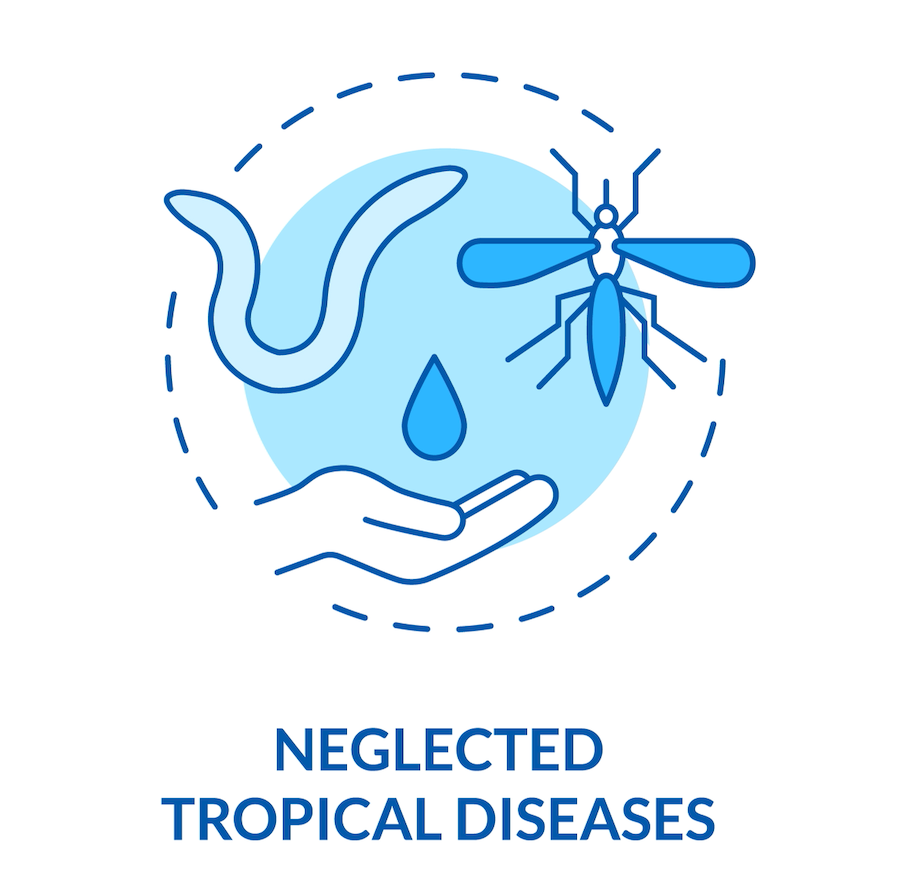World Neglected Tropical Diseases Day, Explained
These diseases, exacerbated by poor water quality, sanitation, and health care access, are highlighted today.

Today, January 30, is World Neglected Tropical Diseases Day. Neglected tropical diseases (NTDs) affect more than 1 billion individuals around the world, and are caused by a variety of viruses, bacteria, parasites, fungi, and other toxins.
NTDs are most prevalent in the poorest regions of Africa, Asia, and the Americas. In addition to inclement weather, poor water quality, sanitation, and health care access exacerbate NTDs in these areas.
These tropical diseases are categorized as neglected because they are almost entirely ignored by the global health agenda and receive very little funding. NTDs are also associated with significant stigma and subsequent social exclusion.
“Diseases of neglected populations,” the World Health Organization (WHO) said in a statement, “perpetuate a cycle of poor educational outcomes and limited professional opportunities.”
The COVID-19 pandemic inevitably slowed the progress against NTDs. However, according to WHO, 47 countries eliminated at least 1 NTD by the end of 2022. Additionally, NTD programs performed better in 2022 than in 2021.
One such advance, in the form of a grant from the Bill & Melina Gates Foundation, was recently awarded to VisualDx. With the grant, VisualDx will continue working to enhance surveillance, detection, and triage of NTDs and other rare infectious diseases.
The WHO lists the world’s NTDs as the following:
- Buruli ulcer
- A debilitating mycobacterial skin infection that can severely devastate the skin, bone, and soft tissue
- Chagas disease
- A deadly protozoan illness transmitted to humans by vector insects, ingestion of contaminated food, infected blood transfusions, organ transplantation, laboratory accidents, or congenital transmission
- Dengue and chikungunya
- Both mosquito-borne, outbreak-prone viral conditions causing a flulike illness that may lead to severe, painful, disabling symptoms. Shock, hemorrhage, and death may occur in dengue patients
- Dracunculiasis (guinea-worm disease)
- A helminth infection only contracted by drinking water contaminated with parasite-infected water fleas. A year after infection, adult female worms painfully ulcerate through the skin, and often the legs, to expel their larvae
- Echinococcosis
- A disease caused by the larval stages of tapeworms forming pathogenic cysts in human organs, contracted by ingesting eggs (commonly shed in dog and wild animal feces)
- Foodborne trematodiases
- Infectious diseases acquired by ingesting fish, crustaceans, or vegetables contaminated with larval parasites. Clonorchiasis, opisthorchiasis, paragonimiasis and fascioliasis are the most common
- Human African trypanosomiasis (sleeping sickness)
- A protozoan infection spread by tsetse fly bites that is almost 100% fatal without rapid diagnosis and treatment to prevent the parasites from infiltrating the central nervous system
- Leishmaniases
- A group of protozoan diseases transmitted through bites from infected female sandflies. The most severe and visceral form attacks the internal organs, while the most prevalent and cutaneous iteration causes skin ulcers, severe scarring, and disability
- Leprosy
- An ancient and complex disease caused by infection with a slow-growing bacterium that primarily affects the skin, peripheral nerves, and eyes
- Lymphatic filariasis (elephantiasis)
- A helminth infection transmitted by mosquitoes that causes adult worms to inhabit and reproduce in the lymphatic system, associated with recurrent painful inflammation and enlargement of limbs and genitals
- Mycetoma, chromoblastomycosis and other deep mycoses
- Chronic, steadily destructing inflammatory diseases of the cutaneous and subcutaneous tissues, usually affecting the lower limbs. Individuals become infected when injuries break the skin, allowing fungi and bacteria to enter the body
- Onchocerciasis (river blindness)
- A helminth infection transmitted by the bite of infected blackflies, causing serious itching and eye lesions that eventually lead to visual impairment and permanent blindness as an adult worm produces larvae
- Rabies
- A preventable viral disease transmitted to humans via bites of infected animals, commonly dogs, that is fatal once symptomatic
- Scabies and other ectoparasitoses
- A group of skin infestations caused by mites, fleas, or lice. Scabies occurs when human itch mites burrow into the upper layer of the skin, living and laying eggs while causing intense itching and rash
- Schistosomiasis (bilharzia)
- A group of trematode infections contracted when larval forms released by freshwater snails infiltrate human skin during contact with infested water. Schistosomiasis is commonly associated with liver and urogenital pathology
- Snakebite envenoming
- A potentially fatal condition caused by toxins injected via venomous snake bite. Often resulting in acute medical emergencies, envenoming can also be caused by certain snake species spraying venom into the eyes
- Soil-transmitted helminthiases
- Helminth infections transmitted through soil contaminated with human feces, causing anemia, vitamin A deficiency, stunted growth, malnutrition, intestinal obstruction, and impaired development
- Taeniasis and cysticercosis
- Taeniasis is caused by adult tapeworms in human intestines, while cysticercosis results from ingesting tapeworm eggs that develop as larvae in tissues (including the brain)
- Trachoma
- A bacterial infection contracted by direct contact with infectious eye or nasal discharge, associated with unsafe hygiene practices and living conditions. If untreated, trachoma causes permanent corneal opacities and blindness
- Yaws
- A chronic and disfiguring bacterial disease that primarily affects the bones and skin. Other endemic treponematoses are also considered NTDs
